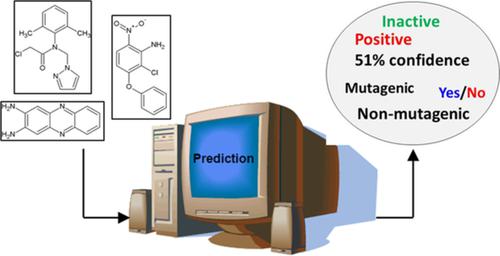当前位置:
X-MOL 学术
›
Pest Manag. Sci.
›
论文详情
Our official English website, www.x-mol.net, welcomes your feedback! (Note: you will need to create a separate account there.)
(Q)SAR tools for the prediction of mutagenic properties: Are they ready for application in pesticide regulation?
Pest Management Science ( IF 4.1 ) Pub Date : 2020-03-29 , DOI: 10.1002/ps.5828 Kristin Herrmann 1 , Andrea Holzwarth 1 , Soyub Rime 1 , Benjamin C Fischer 1 , Carsten Kneuer 1
Pest Management Science ( IF 4.1 ) Pub Date : 2020-03-29 , DOI: 10.1002/ps.5828 Kristin Herrmann 1 , Andrea Holzwarth 1 , Soyub Rime 1 , Benjamin C Fischer 1 , Carsten Kneuer 1
Affiliation

|
The assessment of human health risks resulting from the presence of metabolites in groundwater and food residues has become an important element in pesticide authorisation. In this context, the evaluation of mutagenicity is of particular interest and a paradigm shift from exposure‐triggered testing to in silico‐based screening has been recommended in the European Food Safety Authority (EFSA) Guidance on the establishment of the residue definition for dietary risk assessment. In addition, it is proposed to apply in silico predictions when experimental mutagenicity testing is not possible due to a lack of sufficient quantities of the pesticide metabolite. This, combined with animal welfare and economic considerations, has led to a situation where an increasing number of in silico studies are submitted to regulatory authorities. Whilst there is extensive experience with in silico predictions for mutagenicity in the chemical and pharmaceutical industry, their suitability in pesticide regulation is still insufficiently considered. Therefore, we herein discuss critical issues that need to be resolved to successfully implement (Quantitative) Structure‐Activity Relationship ((Q)SAR) as an accepted tool in pesticide regulation. For illustration purposes, the results of a pilot study are included. The presented study highlights a need for further improvement regarding the predictivity and applicability domain of (Q)SAR systems for pesticides and their metabolites, but also raises other questions such as model selection, establishment of acceptance criteria, harmonised approaches to the combination of model outputs into overall conclusions, adequate reporting and data sharing. © 2020 The Authors. Pest Management Science published by John Wiley & Sons Ltd on behalf of Society of Chemical Industry.
中文翻译:

(Q)SAR诱变特性预测工具:它们准备好用于农药调控了吗?
评估地下水和食物残渣中代谢物的存在对人类健康的危害已成为农药授权的重要组成部分。在这种情况下,对致突变性的评估尤为重要,并且在欧洲食品安全局(EFSA)指南中建议建立从暴露触发的测试到基于计算机的筛查的模式转变,以建立饮食风险的残留物定义评估。另外,建议在计算机上应用由于缺乏足够量的农药代谢物而无法进行致突变性试验时的预测。结合动物福利和经济考虑因素,导致向监管机构提交越来越多的计算机模拟研究的情况。虽然在计算机方面拥有丰富的经验关于化学和制药工业致突变性的预测,它们在农药管理中的适用性仍未得到充分考虑。因此,我们在此讨论关键问题,这些问题需要解决才能成功实施(定量)结构-活性关系((Q)SAR)作为农药监管中公认的工具。为了说明目的,包括了初步研究的结果。提出的研究突出了对农药及其代谢物(Q)SAR系统的可预测性和适用性领域的进一步改进的需要,但同时也提出了其他问题,例如模型选择,接受标准的建立,模型输出组合的统一方法纳入总体结论,适当的报告和数据共享。©2020作者。John Wiley&Sons Ltd代表化学工业协会出版的《害虫管理科学》。
更新日期:2020-03-29
中文翻译:

(Q)SAR诱变特性预测工具:它们准备好用于农药调控了吗?
评估地下水和食物残渣中代谢物的存在对人类健康的危害已成为农药授权的重要组成部分。在这种情况下,对致突变性的评估尤为重要,并且在欧洲食品安全局(EFSA)指南中建议建立从暴露触发的测试到基于计算机的筛查的模式转变,以建立饮食风险的残留物定义评估。另外,建议在计算机上应用由于缺乏足够量的农药代谢物而无法进行致突变性试验时的预测。结合动物福利和经济考虑因素,导致向监管机构提交越来越多的计算机模拟研究的情况。虽然在计算机方面拥有丰富的经验关于化学和制药工业致突变性的预测,它们在农药管理中的适用性仍未得到充分考虑。因此,我们在此讨论关键问题,这些问题需要解决才能成功实施(定量)结构-活性关系((Q)SAR)作为农药监管中公认的工具。为了说明目的,包括了初步研究的结果。提出的研究突出了对农药及其代谢物(Q)SAR系统的可预测性和适用性领域的进一步改进的需要,但同时也提出了其他问题,例如模型选择,接受标准的建立,模型输出组合的统一方法纳入总体结论,适当的报告和数据共享。©2020作者。John Wiley&Sons Ltd代表化学工业协会出版的《害虫管理科学》。



























 京公网安备 11010802027423号
京公网安备 11010802027423号